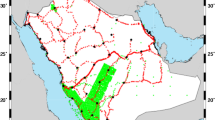Abstract
A new, high-resolution and high-precision geoid has been computed for the whole of Canada and part of the U.S., ranging from 35°N to about 90°N in latitude and 210°E to 320°E in longitude. The OSU91A geopotential model complete to degree and order 360 was combined with a 5′ × 5′ mean gravity anomaly grid and 1km × 1km topographical information to generate the geoid file. The remove-restore technique was adopted for the computation of terrain effects by Helmert's condensation reduction. The contribution of the local gravity data to the geoid was computed strictly by the 1D-FFT technique, which allows for the evaluation of the discrete spherical Stokes integral without any approximation, parallel by parallel. The indirect effects of up to second order were considered. The internal precision of the geoid, i.e. the contribution of the gravity data and the model coefficients noise, was also evaluated through error propagation by FFT. In a relative sense, these errors seem to agree quite well with the external errors and show clearly the weak areas of the geoid which are mostly due to insufficient gravity data coverage. Comparison of the gravimetric geoid with the GPS/levelling-derived geoidal heights of eight local GPS networks with a total of about 900 stations shows that the absolute agreement with respect to the GPS/levelling datum is generally better than 10 cm RMS and the relative agreement ranges, in most cases, from 4 to 1 ppm over short distances of about 20 to 100km, 1 to 0.5 ppm over distances of about 100 to 200 km, and 0.5 to 0.1 ppm for baselines of 200 to over 1000 km. Other existing geoids, such as UNB90, GEOID90 and GSD91, were also included in the comparison, showing that the new geoid achieves the best agreement with the GPS/levelling data.
Similar content being viewed by others
References
Bracewell R (1986) The Fourier transform and its applications. 2nd Edition, Revised, McGraw-Hill, New York.
Brigham E (1988) The fast Fourier transform. Prentice-Hall, Inc., Englewood Cliffs, New Jersey.
Denker H (1990) GPS control of the 1989 gravimetric quasigeoid for the Federal Republic of Germany. IAG Symposia #106 Determination of the Geoid — Present and Future, pp. 152–159, Springer-Verlag New York Inc.
Forsberg R, Sideris MG (1993) Geoid computations by the multi-band spherical FFT approach. Manuscripta Geodaetica Vol. 18, pp. 82–90.
Haagmans RHN, Van Gelderen M (1991) Error variancescovariances of GEM-T1: their characteristics and implications in geoid computation. J. Geoph. Res. Vol. 96, No. B12, pp. 20011–20022.
Haagmans RHN, de Min E, van Gelderen M (1993) Fast evaluation of convolution integrals on the sphere using 1D_FFT, and a comparison with existing methods for Stokes' integral. Manuscripta Geodaetica Vol. 18, pp. 227–241.
Heiskanen W, Moritz H (1967) Physical Geodesy. W. H Freeman and Company, San Francisco.
Mainville A, Veronneau M (1989) Creating a gravity grid over Canada using Bouguer anomalies and a digital elevation model. Presented at the Annual Meeting of the Canadian Geophysical Union, Montreal, Quebec, May.
Milbert DG (1991) GEOID90 A high-resolution geoid for the United States. EOS Trans. AGU Vol. 72, No. 49.
Rapp RH, Wang YM, Pavlis KN (1991) The Ohio State 1991 geopotential and sea surface topography harmonic coefficient models. OSU report No. 410, Department of Geodetic Science and Surveying, The Ohio State University, Columbus, Ohio.
Schwarz KP, Sideris MG, Forsberg R (1990) The use of FFT techniques in physical geodesy. Geophys. J. Int. Vol. 100, pp. 485–514.
She BB (1993) A PC-based unified geoid for Canada. UCGE Report No. 20051, Department of Geomatics Engineering, The University of Calgary, Calgary, Alberta.
Sideris MG (1990) Rigorours gravimetric terrain modelling using Molodensky's operator. Manuscripta Geodaetica Vol. 15, pp. 97–106.
Sideris MG, Li Y (1992) Improved geoid determination for levelling by GPS. In Proc. of the sixth Int. Geodetic Symposium on Satellite Positioning Vol. II, pp. 873–882, Columbus, Ohio, March 17– 20.
Sideris MG, Mainville A, Forsberg R (1992) Geoid testing using GPS and leveling (or GPS testing using leveling and the geoid?). Australian Journal of Geodesy, Photogrammetry and Surveying No. 57, pp. 62–67.
Strang van Hees G (1990) Stokes formula using fast Fourier techniques. Manuscripta Geodaetica Vol. 15, pp. 235–239.
Vanicek P, Ong P, Zhang Changyou (1990) New gravimetric geoid for Canada The UNB '90 Solution. IAG Symposia #106 Determination of the Geoid — Present and Future, pp. 214–219, Springer-Verlag New York Inc.
Veronneau M, Mainville A (1992) Computation of a Canadian geoid model using the FFT technique to evaluate Stokes' and Veningmeinesz' formulas in a planar approximation. Presented at the AGU-CGU-MSA Joint Spring Meeting, Montreal, Quebec, May 12–16.
Wichiencharoen C (1982) The indirect effect on the computation of geoid undulations. Report No. 336, Department of Geodetic Science and Surveying, The Ohio State University, Columbus, Ohio.
Author information
Authors and Affiliations
Rights and permissions
About this article
Cite this article
Sideris, M.G., She, B.B. A new, high-resolution geoid for Canada and part of the U.S. by the 1D-FFT method. Bulletin Géodésique 69, 92–108 (1995). https://doi.org/10.1007/BF00819555
Received:
Accepted:
Issue Date:
DOI: https://doi.org/10.1007/BF00819555




